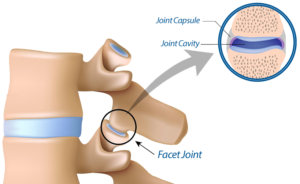What is Facet Disease?
- The sacroiliac joint is in the low back where the spine meets the pelvis
- When the cartilage is damaged or worn away, the bones begin to rub on each other
- Degenerative arthritis occurs commonly in the SI joint
 Facet disease — also called facet syndrome, spinal osteoarthritis, facet hypertrophy or facet arthritis, is a spinal condition occurs when the facet joints in the spine degenerate to the point of causing painful symptoms.
Facet disease — also called facet syndrome, spinal osteoarthritis, facet hypertrophy or facet arthritis, is a spinal condition occurs when the facet joints in the spine degenerate to the point of causing painful symptoms.
Facet joints connect vertebrae (bones) and they work with the intervertebral discs to provide support, stabilisation, shock absorption and flexible movement within the spine. Arthritis and inflammation can develop in these joints.
Facet disease is caused by worn down cartilage as a result of wear and tear, ageing, injury or misuse. This type of injury to the spine can be attributed to arthritis of the spine, over-use or an accident.
Another cause of facet disease is spondylolisthesis, a condition in which one vertebra slips forward in relation to an adjacent vertebra, usually in the lower spine. Facet disease can occur in the neck, middle back and lower back areas.
Our Treatment Approach
To successfully treat your facet disease, it is critically important to know exactly which facet joint is affected. Our team of back and spine specialists will use our highly sensitive pain-mapping technology to pinpoint precisely which facet is causing the problem. They will then perform a minimally invasive surgery using a simple laser to treat the facet joint and relieve your pain.
Our goal is to have you enjoying life again as quickly as possible.
Causes
Facet disease is generally caused by arthritis and inflammation in the facet joints, resulting from ageing, wear and tear, overuse or injury due to an accident. Spondylolisthesis can also cause facet disease.
Symptoms
- Depending on the location of the affected facet joint, symptoms can occur in the neck, middle back or lower back.
- If the problem facet joint is located in the lower back (lumbar) region, it can cause lower back pain that can go to the buttocks and upper thigh area.
- If the affected joint is located in the neck, then pain can occur in the back of the neck and radiate to the top of the shoulders and around the neck.
Since facet joint syndrome develops with age, there is no way to “cure” it with non-surgical treatments.
Please get in touch with an experienced spine surgeon Dr. Abhijit Pawar and book your appointment today.

